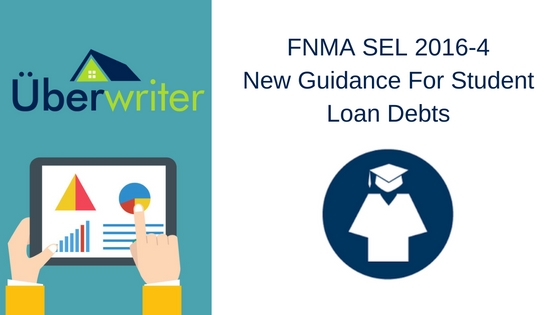As a parent with two kids attending college the discussion of getting through college with minimal student debt (or none at all) has been a topic for the last 5-6 years around my household. I have tried to educate my kids on the pro’s and cons’ of student loans and making student loan payments. I am sure for many people in the mortgage business you see one of those “con’s” on a regular basis, and that is student loan debt can affect your ability to qualify for a home loan!
On August 24th 2015 I posted the blog “Time to review that section about student loan debt” about the changes FNMA guidelines on how to calculate student loan payments for loans that had been in place for years. Over the last few weeks I have received questions on FNMA announcement SEL 2016-04 that has again updated the method FNMA requires when qualifying borrowers with student loan debt.
In the most recent announcement FNMA provides four options to determine an acceptable student loan payments. In my opinion this method is better than the previous “higher of payment on credit report or 1% of the current balance” FNMA was using. Let’s go over these four options, and keep in mind you can choose any of these four options. My method in underwriting is to try to qualify the borrower starting with option one and only moving to the next option if the borrower won’t qualify. This reduces the amount of paperwork the client has to provide. I always teach underwriters to keep things as simple as possible when underwriting.
Student Loan Payments Options
Option 1 – Using 1% of the outstanding balance
No commentary needed here, simple math is balance x 1% = payment
Option 2- Using the actual payment that will fully amortize the loan(s) as documented in the credit report, by the student loan lender, or in documentation supplied by the borrower;
If the borrower’s payment can be documented at lower than 1% of the current balance AND (super important AND) the documentation shows the loan is fully amortized, you can use the payment. Keep in mind if the payment reflected on the credit report is income based repayment, deferred, or a balloon this is not fully amortized and cannot be used.
Option 3- A calculated payment that will fully amortize the loan(s) based on the documented loan repayment terms;
This option is used if the loan is not yet in repayment. Using the original balance, the documented term of the loan, and documented interest rate calculate the borrower’s payment. Keep in mind if 1% payment is lower you can use the 1% payment in lieu of this payment.
Option 4- if the repayment terms are unknown, a calculated payment that will fully amortize the loan(s) based on the current prevailing student loan interest rate and the allowable repayment period shown in the table below.
This is the bullet point that causes the most back and forth between sales and underwriting. The key to this option is the first few words “if the repayment terms are unknown”. If your credit report shows the original balance and term of loan, or any documentation provided to the underwriter shows these elements you cannot use this option. I have had the question come up stating we know the original balance and the term but since we don’t know the interest rate the repayment terms are “unknown’. I disagree with this statement because FNMA provides a link to the federal student loan site that shows the interest rates, so it is not really “unknown”.
Below is the table referenced in option 4.

Last tip to help you out, FHLMC has not changed their stance on student loan debts. So if you have a student loan payment listed on the credit report that makes your deal work, I suggest you use LP and target your loan to FHLMC.
At Uberwriter we love feedback (good or bad). Let us know what you think about this blog. Be sure to submit your questions and we may use your question as a blog topic!


One Response
Very helpful information, I see at least 5 files per week with student loan payments “issues”. I think many borrowers are not fully aware that what they actually pay for a monthly obligation and what mortgage lending requires they qualify with may be quite different numbers.